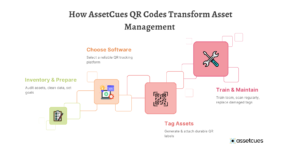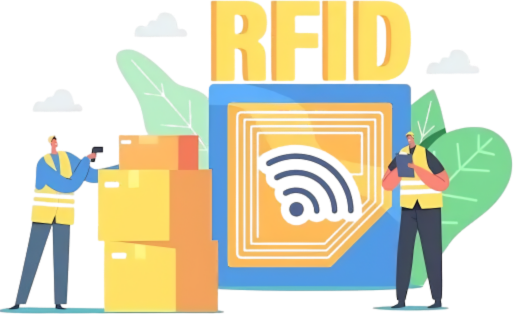Introduction
Managing thousands of assets with spreadsheets or old barcodes is inefficient and error-prone. This outdated approach wastes time and often leads to misplaced equipment. QR code asset management (also known as QR code asset tracking or simply QR asset tracking) offers a smarter solution.
Discover how barcode and QR code asset tracking delivers scalable, cost-effective insights and boosts operational efficiency on the AssetCues blog.
What is it exactly? Each asset gets a unique QR code label, and staff can scan these codes with a smartphone app to instantly access detailed information from a central database. This real-time system lets an employee check an item’s status, location, or history with a quick scan.
QR code labels store more details than barcodes and update records instantly. Moreover, advanced platforms like AssetCues add AI analysis, mobile apps, and integrations. Therefore, these tools transform simple QR tags into a complete asset tracking system.
Ready to Implement the Right Tracking Technology?
Discover how our cutting-edge asset tracking streamlines operations, boosts visibility, and reduces losses.
See it in action with a personalized walkthrough.
Ready to Implement the Right Tracking Technology?
Discover how our cutting-edge asset tracking streamlines operations, boosts visibility, and reduces losses.
See it in action with a personalized walkthrough.
Benefits of QR Codes vs. Traditional Barcodes
When it comes to asset tracking, QR codes offer several advantages over traditional barcodes. They hold more data, scan easily with smartphones, and remain readable even after wear and tear.
-
More Data per Tag:
QR codes hold much more information than traditional barcodes, enabling richer tracking. In fact, a single QR tag can encode hundreds of times more data. One tag stores not only an asset ID but also maintenance dates or documents. Each scan therefore delivers complete context about the asset, not just a number.
-
Easy Smartphone Scanning:
Nearly all smartphones can scan QR codes instantly from any orientation. There is no need for special equipment or precise alignment—just point and scan. Employees can conveniently use everyday mobile devices to scan assets quickly. This accelerates inventories and inspections while eliminating costs of specialized scanners.
-
Durable & Error-Tolerant:
QR codes include built-in error correction, allowing scans despite partial damage. Even with up to 30% of a label compromised, it often remains scannable. By contrast, a scratched barcode may quickly become unreadable and unreliable. QR tags thus perform better in harsh conditions, continuing to scan when labels wear or get dirty.
Given these benefits, it’s no surprise that QR codes are becoming increasingly popular for asset tracking. A quick phone scan yields complete asset information, boosting accuracy and efficiency. In fact, some firms report saving up to 15 workdays per employee each year with QR code systems.
Discover how to choose between barcodes, RFID, and GPS tracking>>
Real-World Use Cases
QR code asset tracking is helping many industries improve accountability and reduce losses. From construction sites to hospitals, organizations are seeing real results in the field.
Construction & Field Service:
Construction companies use QR codes to track tools and equipment across multiple job sites. Workers scan assets in and out using a phone app, ensuring accountability. Managers always know each item’s location and last user, preventing unnecessary losses. One firm cut equipment losses from $30,000 to just $1,500 with QR tracking.
This approach is versatile. Enterprises in IT, manufacturing, healthcare, and other sectors have all seen significant gains from QR code asset tracking. They report fewer missing items and improved asset visibility across the board. In fact, according to an Economic Times report, 62% of businesses expect QR code–focused initiatives to drive revenue growth, underscoring how widely the technology is being adopted across industries.

Overview of AssetCues (Enterprise QR Platform)
One platform that brings all these QR code asset management advantages together is AssetCues. AssetCues is an enterprise QR code asset tracking software solution that combines all the key features in one system.
It uses AI to analyze asset data and even predict needs, such as flagging equipment due for maintenance. Additionally, it offers a robust mobile app that works offline, allowing staff to scan assets anywhere with minimal training. It also integrates with business systems like SAP or ServiceNow to sync asset records and eliminate data silos.
AssetCues can manage millions of assets, and Fortune 500 companies use it globally. At the same time, it remains user-friendly and provides full support to ensure a smooth rollout.
Tips for Implementing QR Code Asset Tracking
So, how can you implement QR code asset tracking in your organization? It’s straightforward if you follow a few best practices for a smooth rollout:
-
Inventory & Prepare:
Audit your assets and clean up the data (ensure each item has a unique ID and current details). Also, define your tracking goals so you know what information you need to monitor.
-
Choose Software:
Select a reliable QR code asset tracking software (such as AssetCues) for your needs. It should support QR code generation, scanning, and integration with your existing systems.
-
Tag Assets:
Generate a unique QR code for each asset using your software, and print each code on a durable label. Affix each label to its asset in a visible spot. Then scan each one with the app to link it to the asset’s record in the database.
-
Train & Maintain:
Train employees to scan QR codes and update details using the app. Since only smartphones are required, the process remains simple and accessible for all. Establish clear rules, like mandatory scans before and after maintenance tasks. Regular audits and prompt tag replacement ensure accurate, up-to-date asset data always.

By following these steps, you’ll have a robust QR code asset management system running smoothly from day one.
Explore how to implement a barcode asset tracking system>>
FAQ
You might still have some questions about adopting QR code asset management. Here are answers to a few of the most common ones:
Q: Should we replace all our barcodes with QR code tags?
A. Not immediately. QR codes provide richer data and simple smartphone scanning. However, companies often keep existing barcodes while adding QR codes to high-value assets. Gradually, they expand tagging as benefits increase, ensuring smoother adoption and greater value. This phased approach balances continuity with improved asset tracking and smarter long-term management.
Q: What are the requirements for a QR code Asset Tracking?
A: Implementation requires just a few basic components:
- Asset management software with QR code support: This software generates the QR codes and serves as the database for your asset information.
- Label printing capability: You need a way to print the QR code labels, ideally on durable materials suited to your environment.
- Smartphones or tablets with the app: Your team will use mobile devices (with the software’s app installed) to scan the QR tags in the field.
That’s it—no special hardware beyond a standard label printer and the mobile devices you likely already have. A platform like AssetCues provides all the necessary software tools (QR code generator, mobile app, cloud database) in one package. This unified solution makes implementation easier.
Q: How durable are QR codes?
A: QR code labels last long when printed on industrial-grade materials like vinyl or aluminum. Moreover, built-in error correction ensures scanning even when 30% is damaged. Therefore, these tags withstand heat, chemicals, and abrasion, often outlasting traditional barcodes. Periodic inspections and replacements further ensure reliable, long-term asset tracking performance.
Upgrade Your Asset Tracking with AI & Barcodes
See how our solution simplifies end-to-end asset management using barcodes, mobile, and AI.
Upgrade Your Asset Tracking with AI & Barcodes
See how our solution simplifies end-to-end asset management using barcodes, mobile, and AI.
Conclusion & Call-to-Action
In summary, QR code asset management gives enterprises a simple yet effective way to track and manage assets. It offers far more efficiency than manual methods or old barcode systems. Tagging assets with QR codes and using a modern platform provides real-time visibility. You can instantly see each asset’s location, status, and history.
Key benefits include faster audits, fewer missing assets, and improved maintenance tracking. Moreover, organizations report cutting audit times nearly in half using QR code tracking. This low-cost upgrade quickly pays back through time savings and loss prevention. Better data visibility also enables smarter, evidence-based decision-making across the organization.
Ready to upgrade your asset tracking? Consider exploring an advanced platform like AssetCues to see how QR code asset management—enhanced with AI insights and mobile scanning—could transform your operations. You might be surprised by how quickly you can boost efficiency and eliminate asset tracking headaches with these tools.
With the right tools, any company can turn asset tracking from a tedious chore into a smooth, automated process. QR codes are the key to this transformation. An enterprise platform like AssetCues can help unlock their potential.
About Author






